|
Leg cramps are sudden and painful contractions of muscles in the legs. They often occur when the body is rest, typically during sleep. The muscle cramps can last for a few seconds or up to several minutes. Muscle groups that mostly involved in leg cramps are calf (back of the lower leg), hamstrings (back of the thigh) and quadriceps (front of the thigh).
Leg cramps are common, many people experience it occasionally, elderly people and pregnant women have a higher risk to develop the problem.
The cause of leg cramps is not well understood, it may be associated with following factors:
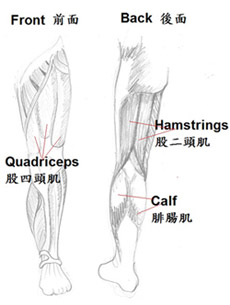 Muscles of the leg
Muscles of the leg
|
 |
Exercising, injury and overuse of muscles |
 |
Exposure to cold temperatures, especially to cold water |
 |
Improper postures e.g. standing or sitting for long periods, or putting the legs in awkward positions |
 |
Dehydration that the body has lost too much fluid, especially in hot conditions |
 |
Poor blood flow e.g. blood vessels narrowing in the legs |
 |
Electrolyte imbalances or mineral deficiencies, e.g. calcium and magnesium |
 |
Pregnancy |
 |
Medications such as diuretics, statins, lithium, prednisone and nicotinic acid |
 |
Health conditions, such as kidney dialysis, liver cirrhosis, alcoholism and hypothyroidism |
1. How to stop a cramping leg?
Most leg cramps respond to gentle massaging and stretching. However, different people may be relieved in different ways, you have to try and find out what works best for your muscle cramps. For calf cramps, you can try as below:
| 1. |
Immediately stand on the legs, lean forward gently to stretch the contracted muscle, hold on until the cramp goes away. |
| 2. |
Sit up, straighten the leg and flex the foot. This can be helped by placing a rolled towel under the ball of the foot, hold the towel at both ends, and gently pull the towel toward the head while keeping the knee straight. Hold in this position until the cramp is gone completely. |
| 3. |
If you can find someone to help, then sit down and straighten the leg, let the helper hold the foot, raise the leg and flex the foot gently toward you, remember to keep the knee straight. |
| 4. |
When leg cramps happen during swimming, try to remain calm, hold the toes and raise them toward the chin. Pinch or bit the upper lip can help calm down if necessary. |
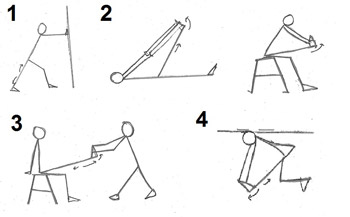 Stretches to stop a cramping leg
Stretches to stop a cramping leg
|
Other useful measures to promote the circulation, ease pain and relax muscles are:
 |
Walk around or jiggle the leg |
 |
Have a warm shower or bath |
 |
Apply hot or cold pad |
 |
Rub along the affected muscles |
 |
OTC pain killer or muscle relaxant can ease the muscle discomfort after a cramp |
 |
Drink water or sports drinks to rehydrate |
In most cases, leg cramps are occasional and harmless. However, when your leg cramps keep coming back, interfering with your daily life or sleep, you should consult a doctor to rule out any potential health problem. Sometimes, your doctor may prescribe anti-spasm drugs too.
In traditional Chinese medicine (TCM), leg cramps are muscle and tendon problems which have both external and internal origins. Since liver stores blood and rules tendons, spleen dominates limbs and rules muscles, and kidney rules bones. When these organs are weakened, that fail to nourish the muscles and tendons, there will be abnormal movements in the limbs. Meanwhile, when external pathogens like coldness and dampness or sports injuries further disturb the blood and
qi (vital energy) activities in the legs, muscle cramps will be induced. Furthermore, the body's blood tend to flow back to the liver for storage at night, less blood flows to the muscles and tendons, and so leg cramps are more readily to occur during sleep.
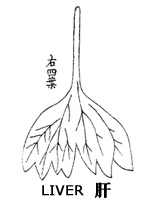 |
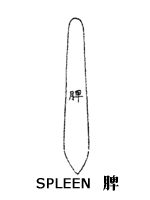 |
| Liver and spleen illustrations in Chinese medicine |
TCM treatment for leg cramps aims to reinforce internal organs, free the activities of blood and qi, nourish and loosen muscles and tendons of the legs. The remedies are chosen according to individual conditions, physicians will identify the symptoms and body signs of each patient to diagnose the body imbalances. Below are common disharmony patterns of leg cramps and the remedies.
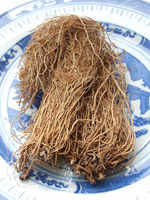 |
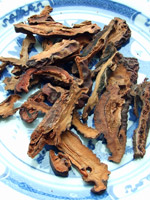 |
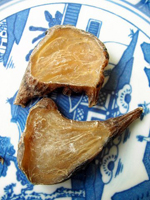 |
| manchurian wildginger |
flowering quince fruit |
aconite root |
2. Herbal prescriptions for leg cramps
Coldness accumulating meridians
Muscle cramps occur in the legs or feet, which result in tightening, pain, and stiffness of the area. The affected leg feels cold and warmth can alleviate the discomfort. The tongue has white and thin coating, and the pulse is taut and tense. The remedy should aim to warm and unblock the meridians, loosen the tendons and relieve pain in the legs.
Sample prescription: Rooster Crowing Powder plus Aconiti Decoction
Coldness and dampness blocking collaterals
Frequent bouts of leg or foot cramps accompany with pain, heaviness, or cold sensation. The discomforts can be alleviated by warmth. Individuals may also have ankle swelling. The tongue coating is white and greasy, and the pulse is slow and soft. The remedy should aim to disperse coldness and dampness, warm the meridians and ease pain in the legs.
Sample prescription: Rooster Crowing Powder plus coix seed, atractylodes rhizome, and peony root
Liver stagnation and blood deficiency
Frequent bouts of leg or foot cramps that result in stiffness, pain, and numbness in the area. Individuals may also accompany with dizziness, headache, mentally depressed, chest or rib sides distending sensation, a sallow face, pale lips and nails, a pale tongue, and the pulse is taut, thready and rapid. The remedy should aim to regulate the liver, nourish blood, unblock the collaterals and loosen the tendons of the legs.
Sample prescription: Six-gentleman Decoction plus angelica root and white peony root.
If serious, add in bupleurum root, donkey-hide gelatin, and flowering quince fruit
Qi and blood deficiencies
Frequent bouts of leg or foot cramps that result in pain and stiffness in the area. Individuals also have fatigue, weakness, feeble voice, breath shortness, dream-disturbed sleep, dizziness, blurred vision, pale lips and nails, a pale tongue and weak pulse. The remedy should aim to replenish qi and blood, loosen the tendons and free the collateral flow in the legs
Sample prescription: All-inclusive Great Tonifying Decoction plus cornus fruit, and flowering quince fruit
In TCM experiences, muscle and tendon problems need weeks of treatment for the desirable results. It is advised to take herbal decoctions, so that physicians can plan a customized regime for each individual, and also make appropriate adjustments during the course of treatment.
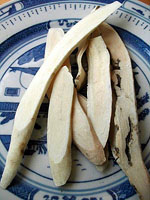 |
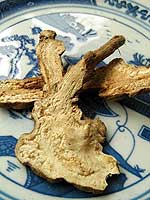 |
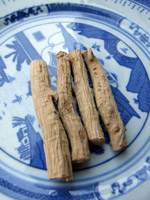 |
| white peony root |
largehead atractylodes rhizome |
towtoothed achyranthes root |
Leg cramps during pregnancy
Leg cramps are common in pregnant women, particularly during the second and third trimesters. Factors that contribute to the problem may be an increased body weight, changes in blood circulation, compression of nerves or blood vessels, or mineral imbalances. The lower legs often cramp at night that causes the pregnant woman wake from a peaceful sleep.
From a TCM perspective, this is mainly due to body deficiency, that plenty of essence and blood are absorbed by the fetus. The muscles and tendons in the legs tend to be under nourished, which can easily be fatigue and induced to cramp. Below are common disharmony patterns of leg cramps during pregnancy.
Yin and blood deficiencies
Frequent bouts of painful cramps in the lower legs or feet, that accompany with irritability, insomnia, dizziness, headache, mouth dryness, and constipation. The tongue is red or pale with thin yellow coating, the pulse is thready and rolling. The remedy should aim to nourish blood and soothe the liver.
Sample prescription: Four-substance Decoction plus abalone shell, fossil bone, oyster shell, and suberect spatholobus stem
Blood and qi deficiencies
Frequent bouts of painful cramps in the lower legs or feet, that accompany with dizziness, headache, fatigue, general weakness, poor appetite, a bland taste in mouth, pale lips and face, a pale tongue with thin and white coating, and the pulse is thready and weak. The remedy should aim to replenish qi and nourish blood.
Sample prescription: Eight-treasure Decoction plus flowering quince fruit and suberect spatholobus stem
3. Acupuncture and moxibustion for leg cramps
Acupuncture and moxibustion can effectively suppress hyperactive muscles, and are usually used for treating muscle cramps. In TCM, leg cramps is mainly due to coldness stimulation as well as improper blood and qi activities of the legs, acupuncture can play a role to promote circulation, loosen the tendons, alleviate cramps and ease pain.
Suggested acu-points: cheng shan (Bl 57), wei zhong (Bl 40), kun lun (Bl 60), yang ling quan (Gb 34) and hou xi (Si 3), and zu san li (St 36).
During an attack, the hou xi (Si 3) on the opposite side is selected. Insert a needle and twirl to achieve a needle sensation, then use reducing method to enhance the stimulations until the cramp go away.
During remission period, the cheng shan (Bl 57), wei zhong (Bl 40), kun lun (Bl 60), yang ling quan (Gb 34) and zu san li (St 36) are stimulated. Apply daily, on alternative side each time, and needle retention with moxa heating or electrical stimulation for 1 hour, 10 times as one treatment course.
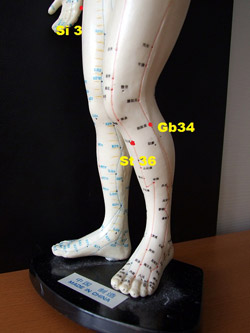 |
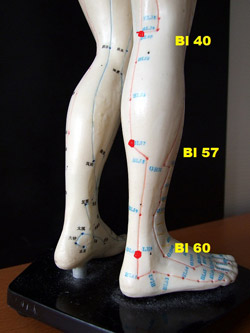 |
| Acupoints for leg cramps |
Acupoints for leg cramps |
** Cupping is also appropriate on these points, and the cups are retained for 5 minutes.
Analysis: the Leg Tai Yang Bladder Meridian runs through the affected region, acupuncture stimulations are usually along this meridian in order to promote blood and qi flows of the legs, e.g. cheng shan(Bl 57), wei zhong (Bl 40), and kun lun (Bl 60). The yang ling quan (Gb 34) is a sea point, where the meridian qi gather together. It is also an influential point that specializes in resolving tendon problem. The hou xi (Si 3) is a confluent point, where it communicates with the
Yang Heel Vessel, and helps regulate lower limbs movement and the sleep cycle.
4. Chinese acupressure for leg cramps
Chinese massage or acupressure involves applying various manipulations to stimulate the soft tissues, stretch the muscles and mobilize the joints, which can promote blood circulation and remove stagnations, restore impaired soft tissues and correct bone and joint deformities. Massage can relax muscles and tendons, reduce pain and soreness, speed up the recovery process and help feel better. Massage is an effective home remedy for relieving and preventing leg cramps.
| 1. |
Hold in fist, rub on the center of the soles to warm it up; |
| 2. |
Press and knead on the points: wei zhong (Bl 40), zu san li (St 36), cheng shan (Bl 57), yang ling quan (Gb 34), kun lun (Bl 60), and hou xi (Si 3). Use the thumb to knead forcefully on each point for 30 seconds; |
| 3. |
Pad the calf muscle: put all the fingers together and slightly flex the palm, then pat on the calf muscles gently for 1 minute; |
| 4. |
Squeeze and roll the calf muscles with both hands, begin at the ankle and move gradually upwards, do this for 2 minutes; |
| 5. |
Straighten the leg, hold the toes and flex the foot toward the knee. |
The above is suggested to be a routine before sleep.
5. Chinese scraping therapy for leg cramps
Scraping therapy promotes the flow of blood and qi, activates the meridians, and induces perspiration to expel pathogens from the body surface, thus facilitating the recovery of the body. It is a simple and convenient way to promote health. The operator uses a tool that lubricated with vegetable oil or warm water to scrape on the body surface until the skin area turns purple-red color.
For lower leg cramps, the selected regions on are the back and along the sides of the spine, and the back of knees. First, clean and wipe the regions with a wet towel, then scrape on the sides of the spine, always scrape in the same direction, apply consistently and enhance the strength gradually. Scrape for 10~20 times on each side, till some reddish stripes appear on the skin. Afterward, scrape the back of the knees in the same way.
Don't scrape on the same place again if the skin patches have not faded. Scraping therapy is NOT suitable for those with severe conditions, skin lesion, bleeding tendency, too skinny, or who are hungry or immediate after meal.
6. Lifestyle tips for preventing leg cramps
If you are likely to develop leg cramps, it is very important to modify some of your life habits in order to reduce the frequency and severity of future cramps.
 |
Eat a well-balanced diet that is rich in calcium and magnesium. |
 |
Avoid staying in front of a blowing fan or air conditioner |
 |
Keep the legs warm |
 |
Always warm up before exercise and stretch after exercise |
 |
Wear shoes that have proper support |
 |
Stay hydrated, sip water regularly throughout the day |
 |
Cut back on drinks that contain alcohol or caffeine |
 |
Stretch the legs regularly, in particular before going to bed |
 |
Moderate exercise are encouraged, such as walking or cycling, so as to strengthen the leg muscles |
 |
Avoid overly tight bedding, make sure that you can sleep with your toes pointing upward |
 |
Pregnant women are recommended to wear supportive stockings, and put up the feet regularly |
 |
Elderly people are advised to take sun bath frequently and supplements as well |
 |
Be relaxed while working or exercising |
7. Foods to help leg cramps
From a TCM perspective, leg cramps are associated with poor circulation and coldness of the legs, therefore, individuals are advised to eat foods that can provide warmth and promote the circulation of body, beneficial foods include black fungus, brown sugar, animal livers, mutton, beef, goose, duck, eggs, rabbit meat, Chinese yam, sesame, glutinous rice, dates, longan pulp, mushrooms, nuts and leek. The daily diet should include a variety of food selections, and frozen and raw foods are better avoided. Furthermore, they should eat more foods that help promote muscles and tendons healing, beneficial foods include chicken, prawn, snake meat, sea cucumber, animal tendons, carp, cuttlefish, taros, celery, mulberry, cherry, carambola, chestnut, walnut, soybean, hyacinth bean, day lily, sweet olive, loofah, onion, ginger, coix seed, cinnamon and fennel, which help disperse coldness and dampness, and improve the circulation of the limbs.
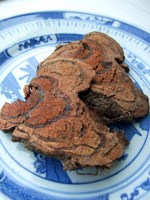 |
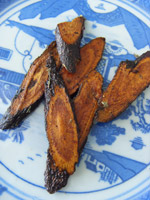 |
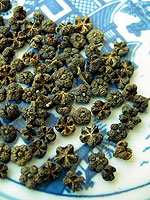 |
| suberect spatholobus stem |
liquorice root
(processed with honey) |
medicinal evodia fruits |
Folk remedies for frequent leg cramps:
| 1. |
White peony root (7.5g), and roasted liquorice root (7.5g). Decoct with 750ml of water, bring to a boil first and then simmer for 30 minutes. Drink daily for 7 days. |
| 2. |
Flowering quince fruit (7.5g), medicinal evodia fruits (6g) and salt (1.5g). Decoct with 750ml of water, bring to a boil first and then simmer for 30 minutes. Drink daily for 7 days. |
| 3. |
Flowering quince fruit (5g), white peony root (7.5g), roasted liquorice root (7.5g), fossil bone (7.5g) and oyster shell (7.5g). Decoct the fossil bone and oyster shell with 1000ml of water first, boil briskly for 30 minutes, then put in other ingredients and simmer for 30 minutes. Drink daily for 7 days. |
| 4. |
Angelica root (4.5g), white peony root (7.5g), oyster shell (15g), suberect spatholobus stem (7.5g) and roasted liquorice root (4.5g). Decoct the oyster shell with 1000ml of water first, boil briskly for 30 minutes, then put in other ingredients and simmer for 30 minutes. Drink daily for 7 days. |
| 5. |
Anemarrhena rhizome (6g), flowering quince fruit (6g), white peony root (6g), roasted liquorice root (6g). Decoct with 750ml of water, bring to a boil first and then simmer for 30 minutes. Drink daily for 7 days. |
| 6. |
Black soybean (vinegar brewed), eat 20-30 pieces daily. |
Leg cramps may be confused with "restless legs syndrome", a condition that makes the legs very uncomfortable, with feelings like creeping, crawling, throbbing, itching or burning. Individuals always complain that they have to move their legs constantly to let the unpleasant feelings go away.
References:
 |
www.mayoclinic.com |
 |
www.medicinenet.com |
 |
Dan Bensky & Ranadall Barolet (Compiled and translated),
Chinese Herbal Medicine íV Formulas & Strategies, Eastland Press 1990. |
 |
Zhu Wenfeng (editor-in-chief), TCM Diagnosis and Differential Diagnosis, People's Medical Publishing House, 1999. |
 |
Wang FuChun (chief reviewer), Hundred Cases of Acupuncture Treatment, Science & Technology Literature Publishing House, 2007. |
 |
Beijing University of TCM (edited), Acupuncture, Academy Press, 1999. |
 |
Gao LuWen, Practical Cupping Therapy of TCM, Academy Press, 2000. |
 |
Qiu Peiran (editor-in-chief), Encyclopedia of Special Treatment in Traditional Chinese Medicine, Wenhui Publishing House, 1993. |
 |
Li Xiumei et al (editor-in-chief), Selected Recipes of Chinese Dietary Remedies, People's Military Medical Press, 2005. |
 |
Zhou Wenquan et al (editor-in-chief), TCM Food Cures Based on Syndrome Differentiation, People's Medical Publishing House, 2002. |
Compiled:
Rose Tse, Integrated Chinese Medicine Holdings Ltd.
Special thanks to Elpidio Talens Juan for helping with article graphics.
|